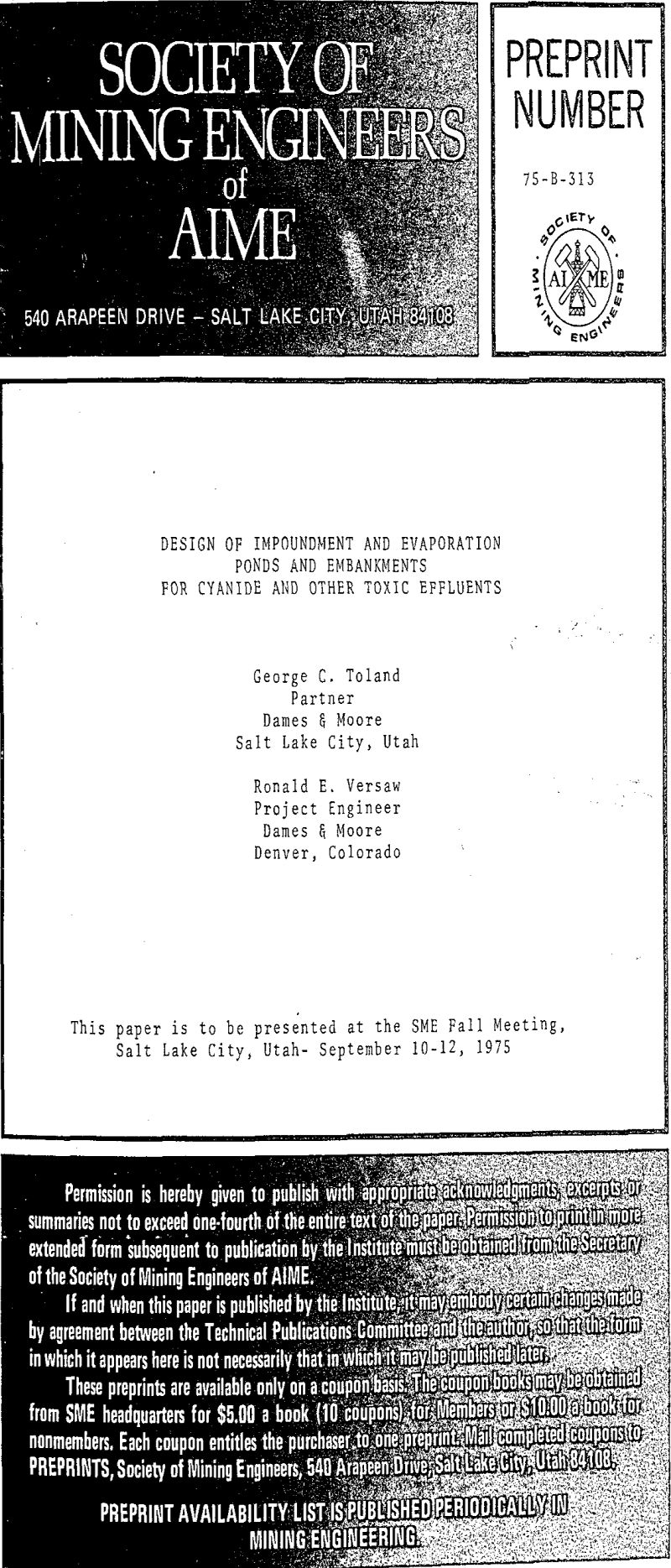Table of Contents
Most existing impoundment ponds and dams leak effluent into the soil or rock upon which they are constructed. However, proposed environmental legislation will require very stringent control on the release of toxic effluents such as cyanide. More exacting investigation, design, and construction techniques than have been used in the past will be required to satisfy these new regulations.
Impoundment, Evaporation Pond and Dam Investigations
Before extensive field, laboratory, and design investigations are performed, it is desirable to obtain all readily-available data pertaining to the proposed impoundment-evaporation pond and embankment site. Sources of information may include air photos, geologic and topographic mapping, borings that may have been drilled in the vicinity of the site, and a review of similar existing structures. After this information has been reviewed, the remainder of the project can be planned, including investigations to obtain technical data not obtained in the preliminary studies.
Since control of seepage from the reservoir and embankment is essential, it is mandatory that a thorough investigation of the subsurface soil and rock be performed prior to designing the facility. At most sites, this will require drilling several exploratory borings, some of which should extend to the static ground water level beneath the site. Information on the ground water beneath the site is critical because an evaluation will have to be made of the potential effect of effluent seepage on ground water quality and flow patterns.
Reservoir Sealing
As stated previously, the most critical design concept for impoundment and evaporation ponds and embankments which contain toxic effluent is sealing the reservoir so that seepage is either eliminated or reduced to a tolerable level. At a few sites, this is accomplished by locating the reservoir on a continuous impermeable rock stratum and keying the impervious section of the embankment into this stratum. Where competent rock exists at shallow depth and covers a sufficiently large area to meet the long-term storage capacity requirements of the project, seepage rates on the order of .01 to 1.0 gallons per minute per acre of pond area can be obtained.
In some instances, it may be possible to line the reservoir using either existing in-situ soils, or imported soils. The feasibility of this approach depends on the properties of the available soils, including soil type, moisture content, and compaction characteristics.
Where silty or clayey soils exist within the reservoir area, they may provide a sufficiently impermeable layer in which to connect the impervious portion of the embankment. However, the same problems of continuity and homogeneity of the soil layer as previously discussed for bedrock linings apply.
Embankment Sections
Sealing the embankment creates problems similar to those of sealing the reservoir. If the reservoir is situated in impervious soil or rock formations where lining is not required, then the most feasible way of sealing the embankment is to use an impervious core and cutoff which contacts the underlying impervious soil or rock.
Sheeting can be placed either on the face of the embankment or in the interior of the embankment. If sheeting is placed at a steeper angle than approximately 3 horizontal to 1 vertical, it is recommended that nylon-reinforced sheeting be utilized. Seepage rates through an embankment with an impervious core or lining are usually small. For practical purposes, no seepage will occur through artificial membrane materials, and overall seepage rates of less than 10 gallons per minute per 100 acres of pond can be obtained with proper design and construction techniques.
Apart from sealing the embankment, several other considerations are important in the design of an embankment for control of toxic effluent seepage. As previously stated, most impoundment and evaporation ponds and dams have been designed with little regard for seepage reduction; in some cases, seepage may have provided additional stability to the embankment by lowering the internal phreatic level.
Surface runoff and direct precipitation into the evaporation and impoundment system becomes very critical for systems containing toxic effluent, and design allowances should be made to compensate for these factors. Probably the most detrimental situation that could occur during the life of an impoundment facility would be overtopping or breaching of the embankment due to excessive storm runoff and inadequate control measures. One such event could do far more harm environmentally than decades of slow seepage from the reservoir or through the embankment.
Special Implications of Cyanide Effluents
The chemistry of cyanide destruction is discussed thoroughly in a paper by Hyatt. In summary, the rate at which cyanide decomposes is increased by exposure to ultraviolet rays, by aeration, and by certain types of aerobic bacteria. Ideally then, an impoundment-evaporation pond and embankment system for cyanide effluents would be constructed with a minimum liquid depth, would contain provisions for aeration, and would be designed so that the effluent could be circulated or agitated periodically to keep dead layers without oxygen from forming in the effluent.
In most cases, it would not be feasible to have an aeration and agitation system similar to that used by sewage treatment facilities, even though this would be ideal for expediting the decay of the cyanide effluent. Nevertheless, innovations such as multiple holding ponds (where the effluent may be periodically flushed from one to the other) might be feasible. The effect of the additional holding ponds would be to speed up the decomposition process of the cyanide. Assuming that the toxicity of the effluent could be reduced to a tolerable level, it would no longer have to be stored and could be discharged. This would reduce the overall storage volume required to hold the tailings and effluent.


